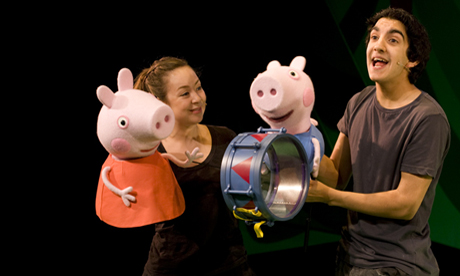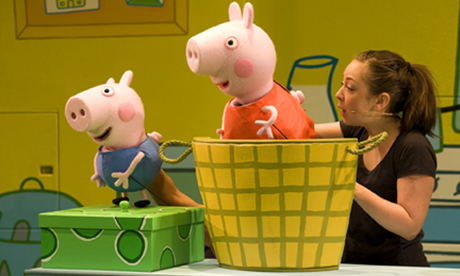Peppa Pig’s Party at the Hackney Empire

Peppa Pig's Party UK tour 09-10 Peppa Pig & Kerry Gooderson George Pig & Phil Adele Photo by Pete Jones
Peppa Pig is now winning the hearts of parents and children alike as she takes to the stage for the first time in her own theatre production, currently on tour across the UK and showing at the Hackney Empire.
Peppa Pig’s Party is a live stage show in which beautifully true-to-life puppets are operated by actors who remain on stage with them, perform alongside them, and provide the voices.
It opened at Exeter’s Northcott Theatre at the beginning of October and is already proving a huge hit with many who have been to see it at the beginning of its first national tour.
Watching a packed matinee performance amidst hundreds of excited children aged anywhere between two and six, it’s easy to see why.
Even the adults are visibly amused, as know-it-all expert Daddy Pig gets into one scrape after another, anxious Mummy Pig tries to bring a sense of order to the day, Peppa’s baby brother George obsesses about dinosaurs, and Peppa and her friends – audience included – sing along to their favourite songs, play games, and partake in Peppa’s favourite pastime of splashing in muddy puddles.
The instantly recognisable setting for the beginning of the story is the garden of Peppa Pig’s house where we are told by Peppa’s addictively cheery friend Daisy that today is a very special day. It’s Peppa’s birthday, she’s having a party, and – yes, that’s right! – we’re all invited.
One-by-one, through a series of hide and seek and guessing games and ‘behind you’ scenarios, each of the characters are introduced to their fans – Danny Dog, Suzy Sheep, Emily Elephant, Daddy Pig, Mummy Pig, and George – until finally the star herself appears, and a series of delightful edge-of-seat adventures begin.
Directed by Richard Lewis, who also adapted Peppa Pig for the stage, with music from LazyTown composer Mani Svavarsson, the Fiery Angel and Limelight Productions team have gone to huge lengths to ensure that none of the magic of the original animation series has been lost during the transition from small screen to stage.
Key to their success has been the contributions made by the show’s puppetry consultant Nigel Plaskitt who, after 35 years’ experience in children’s television, believes that in Peppa Pig he sees a winning formula that has been lacking from children’s programmes for some years.
LAMDA-trained, Nigel was a jobbing actor when the chance to work on the 1970s cult children’s TV programme Pipkins came along.
It was an experiment. The year was 1972 and until that point ITV day-time did not really exist.
Aside from the occasional film here or there, viewers during working hours mostly found themselves tuned in to the station’s test card. One of the first day-time pre-school programmes on ITV, Pipkins ran for nine years.
“I was in my early 20s, so I had mixed feelings about Pipkins. It was an interesting job, but not exactly what I had set out to do,” Nigel admits, “until I began to realise what a skill it was to be a good puppeteer.”
At almost exactly the same time, Nigel was cast as long-suffering Malcolm in the Vick’s Sinex campaigns.
“By then, I’d totally got ‘wanting to be famous’ out of my system. Yet through Hartley Hare and the advertising campaign I was becoming recognised for my work anyhow,” says Nigel, who went on to work on Spitting Image as the puppeteer responsible for some of the satire’s most popular characters, among them John Major and Ian McAskill.
Other series among his many credits include The Hitch Hiker’s Guide To The Galaxy, Dr Who, and various Muppet adventures.
Growing up in the 1950s, Nigel’s childhood television viewing comprised largely of puppet-led programmes like Andy Pandy, Sooty, and Muffin The Mule. And while today’s producers have the technology to create whizz-bang special effects and eye-popping visuals, he believes the use of puppetry to capture a child’s attention will never fade away.
“It’s because they are not human,” he observes. “Puppets are nearly always some kind of animal or abstract being, so they fire a child’s imagination. Also, children see puppets as similar to their own toys, which they bring to life at home while playing. That’s why children don’t really notice the puppeteer.
“Adults, on the other hand, do. When they first begin watching Peppa Pig’s Party, they’ll find it takes them a minute or two to adjust. But children have this ability to instantly suspend disbelief, so that whether the character is real or not becomes irrelevant towards their enjoyment of what they are watching.”
“We used the same concept for the puppets in Peppa Pig’s Party that we developed for Avenue Q,” says Nigel, referring to the West End musical in which he is also currently involved – a Sesame Street spoof for adults.
“With this show, we also decided against animatronics, as we didn’t feel there was a need to make Peppa and her pals any more believable than they already were,” adds Nigel. “After all, Miss Piggy went around for years without ever blinking.”
“Choosing to use puppets was a risk, but I knew it would work much better than using adults dancing around in costumes for this kind of show,” he continues.
“Costumes can be cumbersome on stage, and to a child they can be quite terrifying. If we had made Peppa 5 feet tall in skins or football mascot style outfits, for example, to keep everything to scale, Daddy Pig would have had to have been 10 feet tall, and would have ended up looking more like a hot air balloon.”
Satisfied with the end product, Nigel hopes the popularity of the stage show as well as the Peppa Pig television series, magazines, DVDs, and other merchandise, might signal a positive way forward for children’s entertainment in future.
Nigel says, “I think what has happened over the years in children’s television is that while people have been looking for the next new thing, they have not realised we were right with what we were doing in the first place.
“In the 1980s, we were being told that what had been done in the 1970s was old hat. It was thought by some that children’s attention spans were becoming shorter, so programmes had to become fast-moving, with lots of cutting and shouting to keep them alert.
“None of that is true. The Pipkins DVDs have just come out. These programmes ran at a completely different pace to most of today’s children’s television programmes, yet parents are telling me their children have been watching them back-to-back and would like to see more.
“I think this is what Peppa Pig has hit upon; it has gone back to that simplistic, slower-paced way of presenting a children’s programme that’s not too in-your-face and has a much nicer feel to it.
“In both the animation and the stage show, Peppa and all the other characters are so endearing that we warm to them instantly. They are funny, and they talk in a language we all understand, rather than just gargling. And each episode tells a good story from beginning to end.
“There’s something very uplifting about these little characters. Then, of course, there’s that special way Peppa says ‘Oink!’, which is perfect, as children love to hear silly noises. Finally, there are all those little personality traits in each of the characters that, whatever our age, we can recognise in either ourselves or someone we know!”.
Work began on Peppa Pig’s Party back in February, which is when Nigel called upon Avenue Q colleague Paul Jomain to build the puppets, assisted by Nicola Tedman and Maria Swindell.
For Nigel and Paul, it was an advancement of a pre-existing successful partnership, as puppeteer and puppet builder for Monkey in the ongoing PG Tips adverts – and you thought the only long-term pairing in that was Monkey and Johnny Vegas as Al.
For his latest labour of love, Peppa, Paul literally went back to the drawing board.
“I looked at the illustrations and realised they were perfect for puppets,” he says. “They are such simple designs, so it was a case of matching them up to actors’ hand sizes to see how they would be able to work them.
“Recreating a famous character like Peppa, the pressure was on,” he continues. “But the first reward came about nine weeks into building her. Word spread around my village as to what I was building and a neighbour brought her young family around to see. Even though Peppa was lifeless on a stand, at once they wanted to reach out and touch her as if she was real.”
With children having given their seal of approval, it was now the turn of the adults.
“Once I’d built Peppa, I took her along to the animation company’s offices in Regent Street to show them,” says Paul.
“She was hidden inside a large bag in a very unglamorous way, but when I plucked her out of it, it was as if everyone in the room regressed into childhood. It was great. For me, the facial expressions said it all. That’s what these puppets do to you.
“A friend of mine says that every time she looks at them, she comes close to tears because they seem so cute. The show has only just opened, and already toddlers are feeling so at ease with the puppets, they’re trying to come up on stage to meet them.”

Peppa Pig's Party UK tour 09-10 George Pig Peppa Pig & Kerry Gooderson Photo by Pete Jones
Peppa Pig’s Party, 30 October 2009 – 1 November 2009
Main House, Hackney Empire
Price(s): £12.50 – £14.50 U16s £2 off full price. Family Ticket £50 (two adults, two children)
More information and the show’s website.
